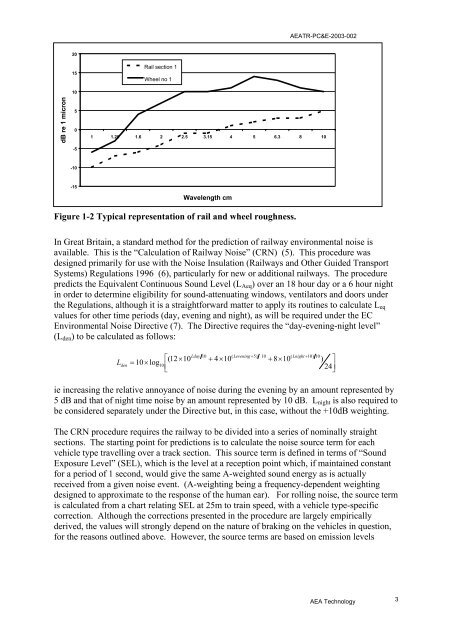Rail and wheel roughness - implications for noise ... - ARCHIVE: Defra
Rail and wheel roughness - implications for noise ... - ARCHIVE: Defra
Rail and wheel roughness - implications for noise ... - ARCHIVE: Defra
Create successful ePaper yourself
Turn your PDF publications into a flip-book with our unique Google optimized e-Paper software.
AEATR-PC&E-2003-002<br />
20<br />
15<br />
<strong>Rail</strong> section 1<br />
Wheel no 1<br />
dB re 1 micron<br />
10<br />
5<br />
0<br />
-5<br />
1 1.25 1.6 2 2.5 3.15 4 5 6.3 8 10<br />
-10<br />
-15<br />
Wavelength cm<br />
Figure 1-2 Typical representation of rail <strong>and</strong> <strong>wheel</strong> <strong>roughness</strong>.<br />
In Great Britain, a st<strong>and</strong>ard method <strong>for</strong> the prediction of railway environmental <strong>noise</strong> is<br />
available. This is the “Calculation of <strong>Rail</strong>way Noise” (CRN) (5). This procedure was<br />
designed primarily <strong>for</strong> use with the Noise Insulation (<strong>Rail</strong>ways <strong>and</strong> Other Guided Transport<br />
Systems) Regulations 1996 (6), particularly <strong>for</strong> new or additional railways. The procedure<br />
predicts the Equivalent Continuous Sound Level (L Aeq ) over an 18 hour day or a 6 hour night<br />
in order to determine eligibility <strong>for</strong> sound-attenuating windows, ventilators <strong>and</strong> doors under<br />
the Regulations, although it is a straight<strong>for</strong>ward matter to apply its routines to calculate L eq<br />
values <strong>for</strong> other time periods (day, evening <strong>and</strong> night), as will be required under the EC<br />
Environmental Noise Directive (7). The Directive requires the “day-evening-night level”<br />
(L den ) to be calculated as follows:<br />
L<br />
den<br />
= 10×<br />
log<br />
10<br />
Lday 10<br />
( Levening + 5) 10<br />
⎡ (12×<br />
10 + 4×<br />
10 + 8×<br />
10<br />
⎢<br />
⎣<br />
( Lnight + 10) 10<br />
) ⎤<br />
24⎥<br />
⎦<br />
ie increasing the relative annoyance of <strong>noise</strong> during the evening by an amount represented by<br />
5 dB <strong>and</strong> that of night time <strong>noise</strong> by an amount represented by 10 dB. L night is also required to<br />
be considered separately under the Directive but, in this case, without the +10dB weighting.<br />
The CRN procedure requires the railway to be divided into a series of nominally straight<br />
sections. The starting point <strong>for</strong> predictions is to calculate the <strong>noise</strong> source term <strong>for</strong> each<br />
vehicle type travelling over a track section. This source term is defined in terms of “Sound<br />
Exposure Level” (SEL), which is the level at a reception point which, if maintained constant<br />
<strong>for</strong> a period of 1 second, would give the same A-weighted sound energy as is actually<br />
received from a given <strong>noise</strong> event. (A-weighting being a frequency-dependent weighting<br />
designed to approximate to the response of the human ear). For rolling <strong>noise</strong>, the source term<br />
is calculated from a chart relating SEL at 25m to train speed, with a vehicle type-specific<br />
correction. Although the corrections presented in the procedure are largely empirically<br />
derived, the values will strongly depend on the nature of braking on the vehicles in question,<br />
<strong>for</strong> the reasons outlined above. However, the source terms are based on emission levels<br />
AEA Technology 3
















